Research - (2021) Volume 0, Issue 0
Peculiarities of zooplankton cenosis structure and development in the middle water area of Kremenchuk Reservoir, Dnieper River (Ukraine), in conditions of elevated temperatures
N.Ya. Rudyk-Leuska*, M.I. Khyzhniak, M.V. Leuskyi, N.Yu. Yevtushenko, V.M. Kondratіuk, R.V. Kononenko and N.I. TsonAbstract
An analysis of the research results on the quantitative and qualitative composition of zooplankton in the middle part of the Kremenchuk reservoir in the water area near Chervona Sloboda, Lesky, and Khudyaki in August 2016 is presented аt elevated temperatures. Of particular note is the first decade of the month, when there was a shift in maximum temperature to +25.42 ± 0.15°C (Cv=1.86%). In general, the water temperature was unstable; its maximum values were a stress factor for plankton invertebrates of the reservoir. It is established that for each section of the water area, certain specific Rotifera species are characteristic of zooplankton: Hexarthra mira (Hudson, 1871)–at station 1; Lepadella patella (O.F. Muller, 1786), Mytilina mucronata (Müller, 1773), Brachionus forficula Wierzejski, 1891, Br. budapestinensis (Daday, 1885)–at station 2; Polyarthra euryptera (Carlin 1943; Bartos 1950; Nipkow 1952; Sudzuki 1964), Lecane luna (Müller, 1776), Synchaeta monopus (Plate, 1889), Asplanchna priodonta var. henrietta Langhans, 1906, Alona quadrangularis (O.F. Müller, 1776)–at station 3. The total zooplankton quantity and the temperature of the aquatic environment increased from the top to the bottom, and the difference between them was 3.3 times in number and 2.4 times in biomass. A positive close and significant correlation (k=0.83 and k=0.65, respectively) with changes in the temperature factor of the aquatic environment in space was established. This indicates the adaptation of aquatic organisms to the environmental conditions where they occupy habitats most favorable for their habitat. On average, the basis of zooplankton was formed by eurythermic organisms-rotifers 64 ± 1.23% in number and 33 ± 6.18% in biomass, which are better adapted to significant fluctuations in daily temperature (recorded differences of 2-8°C/day). Branched crustaceans, mostly thermophilic, accounted for only 7-41% in number and 8-19% in biomass, indicating unfavorable conditions for their development. The close negative correlation (k=-0.78 and k=-0.60) of Cladocera biomass with maximum temperatures indicates the death of primarily large forms of branched crustaceans under the influence of elevated temperatures. Thus, temperature changes, as the influence of climatic factors, has more negative than positive effects. The influence of extreme temperatures of weather conditions leads to a decrease in the productivity and feeding of this aquatic ecosystem.
Keywords
Zooplankton, aquatic organisms, Kremenchuk reservoir, temperature.
Introduction
Forage organisms of water bodies and other aquatic organisms are significantly affected by various environmental factors. The most important among them are temperature, light, gas regime, the content of nutrients. Temperature is a universal environmental factor, and considering the problem of climate change associated with global warming, it may cause some changes in the biota structure of aquatic ecosystems (Janauer, 2012). According to Hutchins et al. (2017), the changes will primarily affect prokaryotes and eukaryotes, which control the biogeochemical cycles of water bodies and face a set of complex anthropogenic changes and environmental factors that are in constant motion –pH, CO2 content, temperature, redox potential, solar radiation nutrients. Under such conditions, cyanobacteria and denitrifiers may be pure beneficiaries of these changes, others - calcifiers and nitrifiers will be adversely affected, and heterotrophic bacteria may be relatively resistant. Such structural changes may ultimately affect large-scale carbon and nutrient cycles changes in water bodies (Hutchins, 2017). Similar changes are observed in artificially created plain reservoirs, where anthropogenic load and environmental factors significantly impact biocenosis (Shcherbak, 2019; Buryak et al., 2020).
The zooplankton group, like other cenoses, is sensitive to temperature changes. It affects their distribution and structural and functional organization–growth, development, productivity, competition, and more (James, 2000).
The construction of dams along the Dnieper River was a severe intervention in the river ecosystem and zooplankton. The research results indicate that after the creation of the Kremenchuk Reservoir, starting in 1961, the biomass of zooplankton has undergone very significant fluctuations. In the beginning, the plankton fauna of the reservoir was formed by combining the bio fund of the river, its floodplain areas, and standing water bodies located downstream (Gusinska, 1969; Kotovska et al., 2010). Subsequently, the maximum values were recorded in the first years, particularly in 1963: up to 7.70 mg/dm3 in the pelagic and even higher (2.3 times) in the heated areas of the bay habitats up to 17.70 mg/dm3. A positive role here was played by a decrease in the flow velocity in the bays, a smaller depth, where the water column warms up faster and stimulates the development of biological processes.
The bays always have large areas of overgrown shallow water, rich in dead organic residues, as a source of nutrients for zooplankton. Five years later, the rates fell 9.6 and 6.1 times, respectively (Gusinska, 1969; Pidgayko,1969).
In the '70s, the values varied from 0.25 to 5.69 mg/dm3, and only in shallow water an increase to 22.10 mg/dm3 was recorded (Zimbalevskaya, 1989). In the early '90s, the values continued to decline, but the species spectrum of zooplankton remained unchanged (Bohdanova, 1939). In 2002–2005, zooplankton biomass of the Kremenchuk Reservoir decreased to the lowest values: at the level of 0.06–1.01 mg/dm3, which is characterized as a "low" level of feeding the reservoir with forage zooplankton. These were the lowest indicators for the entire period of existence of the Kremenchuk Reservoir. The level of development of phytoplankton groups in the same period was also low -1.09–7.49 mg/dm3. Slightly higher biomass was observed in the bays (Kruzhilina et al., 2007).
During 2005-2007, according to the experts' assessments, the number of zooplankton varied between 3.50-146.0 ind/dm3, biomass 0.06-1.7 mg/dm3. The biomass index gradually increased from the upper part, where it was 0.05 mg/dm3, to the middle one, where it was increased 4.4 times, and in the lower part, it was already 6.8 times higher than the initial value. The highest values were registered in Tsibulska Bay 2.28 mg/dm3 (Kotovska et al., 2010).
The part of the Kremenchuk reservoir studied by us differs in the considerable area of shallow water, has insignificant water exchange due to the slow current and specific features of a temperature mode due to warming up in the spring and the summer. The water here is enriched with nutrients from the catchment area and bottom sediments, which provides intensive development of a natural feed base for feeding young fish and older age groups of various fish. In this section of the river and reservoirs, the reservoir is characterized by a rich species diversity of young fish in the summer. Moreover, even some sources note the uniqueness of ichthyofauna yearlings in this part of the reservoir (Kotovska et al., 2010). Thus, developing a natural feed base that meets the nutritional needs of fish is very important here.
Zooplankton cenoses are complex biological systems that are sensitive to changes and very informative with the right approach to understanding them (Sokolova, 2012). In addition to the constant water level fluctuations caused by the sluice system of water supply regulation in reservoirs, many artificial, abiotic, and biotic factors impact zooplankton coenoses —an authoritative international group of experts in Switzerland (Bates et al., 2008).
A detailed analysis of the results of several years of research has shown that the temperature directly impacts the formation and development of zooplankton groups of the Kyiv reservoir of the Dnieper. In particular, an inverse correlation was established with the quantitative characteristics of zooplankton (Pashkova, 2017).
According to our long-term observations, August was the hottest month of the year. We found significant temperature fluctuations during the growing season of 2016 in the Kremenchuk reservoir (Rudyk-Leuska et al., 2020a). The effect of high temperature was accompanied by partial death of higher aquatic organisms (Rudyk-Leuska et al., 2020b). Zooplankton coenoses are complex biological systems sensitive to climate change (Sokolova, 2012) and very informative with the right approach to understanding them (Pashkova, 2017). Therefore, it is essential to investigate the state and principles of formation of zooplankton groups in the middle section of the Kremenchuk Reservoir in August 2016 under the influence of high-temperature factors.
Materials and Methods
We focused on three sections of the Kremenchuk Reservoir: near the village of Chervona Sloboda (station 1), the village of Lesky (station 2), and the village of Khudyaky (station 3), located in the middle section of the Kremenchuk Reservoir within the Cherkasy region, Ukraine (Fig. 1).
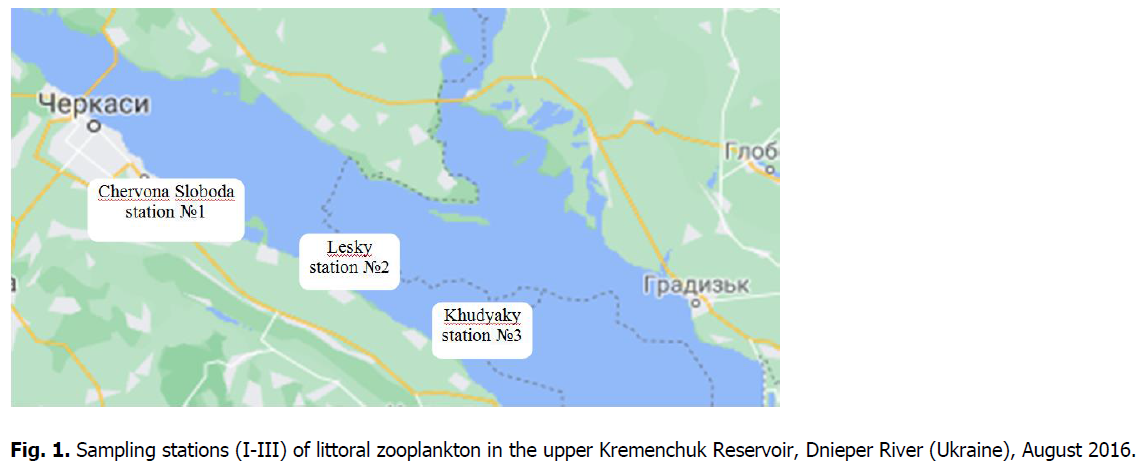
Figure 1: Sampling stations (I-ІІI) of littoral zooplankton in the upper Kremenchuk Reservoir, Dnieper River (Ukraine), August 2016.
The peculiarity of this water area is the predominance of floodplains with mostly sandy, occasionally stony soil; they are overgrown and shaded by floating sedges (Potamogeton natans L, 1753) and common reed (Phragmites australis (Cav.) Trin. Ex Steud., 1841). There is much shallow water with a depth of 0.5-4.0 m, which warms upl.
The water temperature was measured daily. The values of tmax, tmin, tmed were recorded.
Collection, processing, and analysis of zooplankton material were carried out according to generally accepted methods (Zhadyn, 1960; Manuylova, 1964; Monchenko, 2003; Pesenko, 1982; Kutikova 1970, Арсан, 2006).
Statistical data set processing was performed using a Statistica software (Magurran, 2004).
Results and Discussion
The thermal regime of the reservoir changed under the influence of weather conditions. Having made an in-depth analysis of temperature factors (Rudyk-Leuska, 2020 (1,2)), we saw that special attention should be paid to the daily maximum water temperature as the most stressful factor of the thermal regime of this aquatic ecosystem. So, the first decade of the month was the warmest. As a result, there was a shift in the daytime temperature t max to +25.42 ± 0.15°C, where the coefficient of variation Cv=1.86% is low and indicates a consistently high daytime temperature at the beginning of the month. As a result, according to the data presented in the literature (Rudyk-Leuska, 2020 (2)), it was at this time that overseas phenomena of crayfish and fish were observed in some places. In the second decade of the month, there was a sudden decrease in water temperature, and the index t max dropped to +22.13 ± 0.49°C (Cv=6.97%). In the third decade of the month, the indicators were more stable; the indicator t max was +23.10 ± 0.25°C (Cv=3.37%). In general, the oscillations of the variables of tmax, tmin, tmed correspond to the polynomial distribution of the approximation (Fig. 2) with the highest value of the determination coefficient R2=0.58 of tmax parameter (Fig. 2). Therefore, the temperature conditions of the aquatic environment of the Kremenchuk reservoir were unstable; the maximum values of tmax were a stress factor for living organisms of the reservoir.
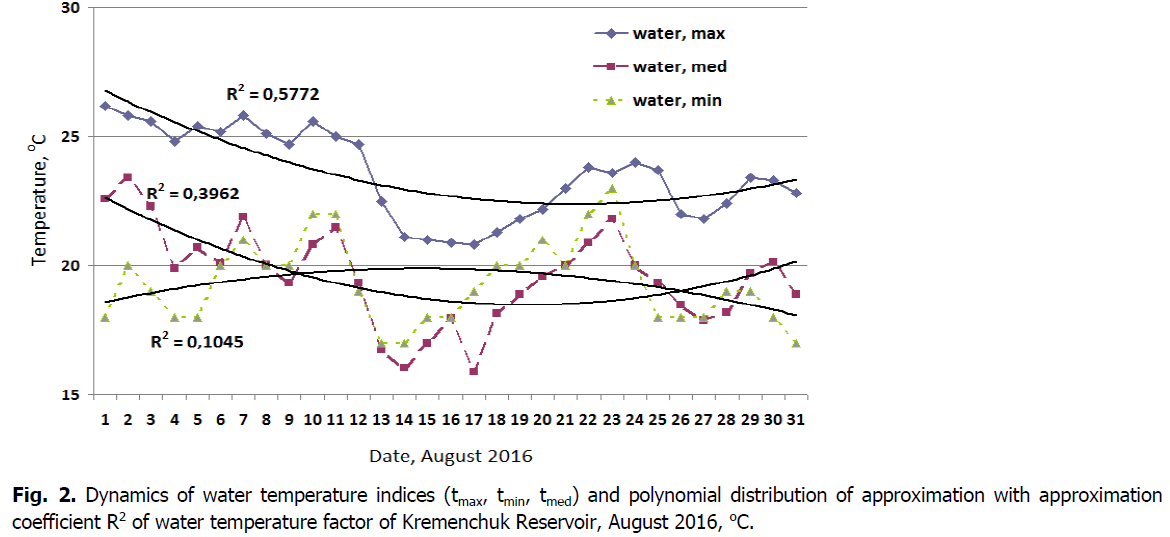
Figure 2: Dynamics of water temperature indices (tmax, tmin, tmed) and polynomial distribution of approximation with approximation coefficient R2 of water temperature factor of Kremenchuk Reservoir, August 2016, °C.
During the sampling period, reservoir zooplankton was represented by organisms belonging to three systematic groups: the type lowerworms Rotifera, the crustacean suborder Cladocera and the Copepoda order, which are characteristic to all freshwater reservoirs. They played a significant role in the formation of zooplankton abundance and biomass.
Plankton forms of larvae of the Dreissena genus were also found among organisms.
In addition, there were also planktonic forms of larvae of filter-mollusks of the genus (family) Dreissena.
A total of 33 taxa of zooplankton organisms were found in the reservoir. In the qualitative composition, there were 23 species of Rotatoria (which accounted for 70% of the total species representation), six species of branched crustaceans (Cladocera) - (18%), three species of paddle-legged crustaceans (Copepoda)-(9%) and larvae of bivalves (3%).
Twenty taxa of zooplankton organisms were found in the area of station №1. The most important among them were rotifers - 13 species (65%), among branched crustaceans, found four species (20%), two species of-(10%). The most represented were the genera: Lecane, Asplanchna, Keratella. Rotifera Hexarthra mira (Hudson, 1871) was found only in this area.
Twenty-two plankton invertebrates fauna taxa were found in the area of station №2. Rotifers occupied the most significant share among them–14 species (64%), branched crustaceans were represented by four species (18%), three species of rowan crustaceans (13%). The most represented were the Rotifera genera: Brachionus, Asplanchna, Euchlanis, Mytilina. Only within this water area were found rotifers of the species Lepadella patella (O.F. Muller, 1786), Mytilina mucronata (Müller, 1773), Brachionus forficula Wierzejski, 1891, Br. budapestinensis (Daday, 1885).
Twenty-five taxa of zooplankton organisms were recorded in the area of station №3. The most important among them were rotifers 18 species (72%), branched crustaceans–5 species (20%), two species of rowan crustaceans-(8%). The most represented were the genera: Asplanchna, Lecane, Brachionus, Bosmina. The species which became specific for this part of the reservoir are Polyarthra euryptera (Carlin 1943; Bartos 1950; Nipkow 1952; Sudzuki 1964), Lec. luna (Müller, 1776), Synchaeta monopus (Plate, 1889), Aspl. priodonta var. henrietta Langhans, 1906, Alona quadrangularis (O.F. Müller, 1776).
Thus, the taxonomic composition in zooplankton was dominated by representatives of the rotator-cladoceran complex, which is characteristic of reservoirs with preserved river regimes and rheophilic conditions.
Fig. 3 graphically presents the process of succession of the species representation of the zooplankton in the water area of the middle section of the Kremenchuk Reservoir at sampling stations. We suggested an increase in the species richness of zooplankton from the top to the lowland. This process is most pronounced in rotifers: their changes are expressed in the logarithmic distribution of the approximation with a high-reliability R2=0.78 (Fig. 3). There is much shallow water; the flow rate decreases, and the water heats up by 1.5-2.0°C higher. There was a statistically significant increase in the species composition of the lower Rotifera worms in the lowland Khudyaky area relative to the apex (Chervona Sloboda, P<0.001) and relative to the middle area (Lesky, P<0.001). Furthermore, these indicators have (k˃0.697) a significant correlation with the indicators of heating the water mass of the pelagic in the reservoir.
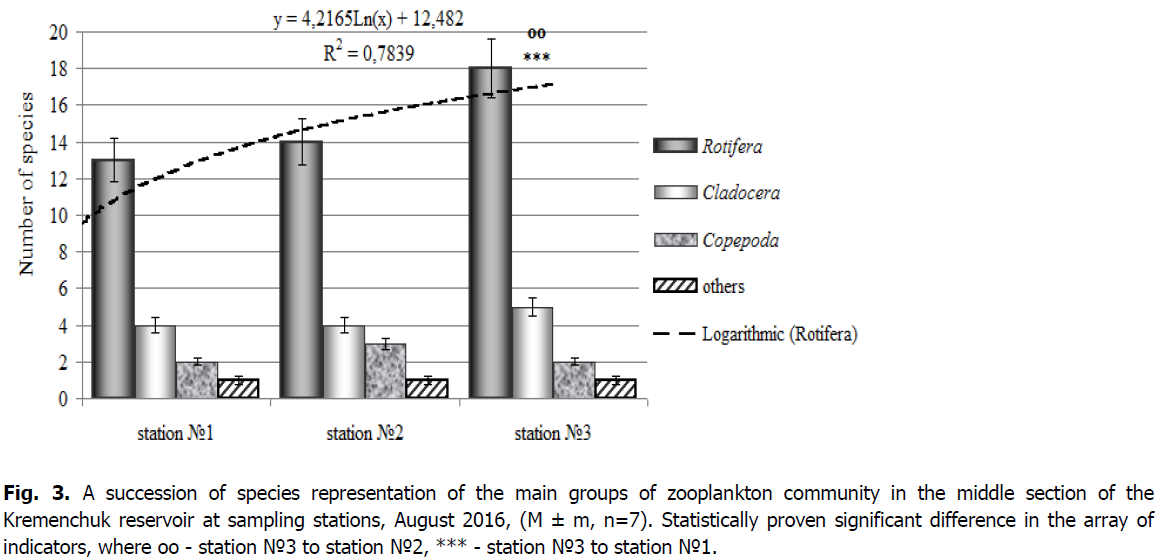
Fig. 3. A succession of species representation of the main groups of zooplankton community in the middle section of the Kremenchuk reservoir at sampling stations, August 2016, (M ± m, n=7). Statistically proven significant difference in the array of indicators, where оо - station №3 to station №2, *** - station №3 to station №1.
At the station No.1 the number was 282 ± 17.86 (Cv=16.71) ind./dm3, the biomass of zooplankton was 2.59 ± 0.35 (Cv=35.32) mg/dm3 (Fig. 4 and 5). In percentage terms, rotifers (Rotatoria) accounted for 62.8% in terms of numbers and 21.2% in terms of biomass, branched crustaceans (Cladocera) were 10.6% and 41.3%, respectively. A significant proportion of Dreissena larvae-veligers, which led a planktonic lifestyle and amounted to 11.6% of the total zooplankton, is a feature of zooplankton in this area. Development values were 54 ± 2.01 ind./dm3 (Cv=9.77) (number) and 0.54 ± 0.02 mg/dm3 (biomass). Their share in zooplankton was 19-21%.
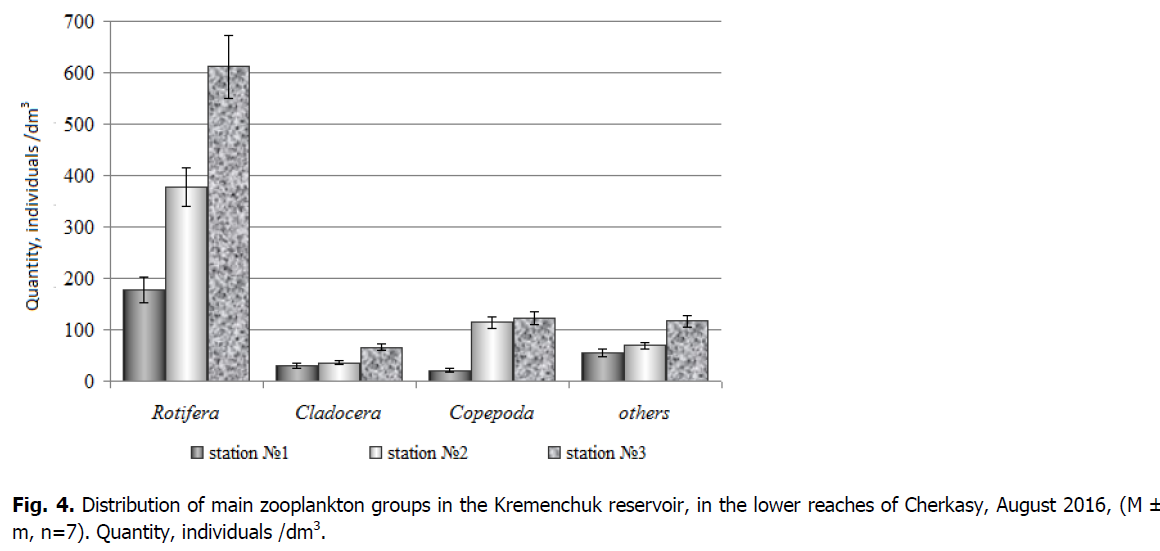
Figure 4: Distribution of main zooplankton groups in the Kremenchuk reservoir, in the lower reaches of Cherkasy, August 2016, (M ± m, n=7). Quantity, individuals /dm3.
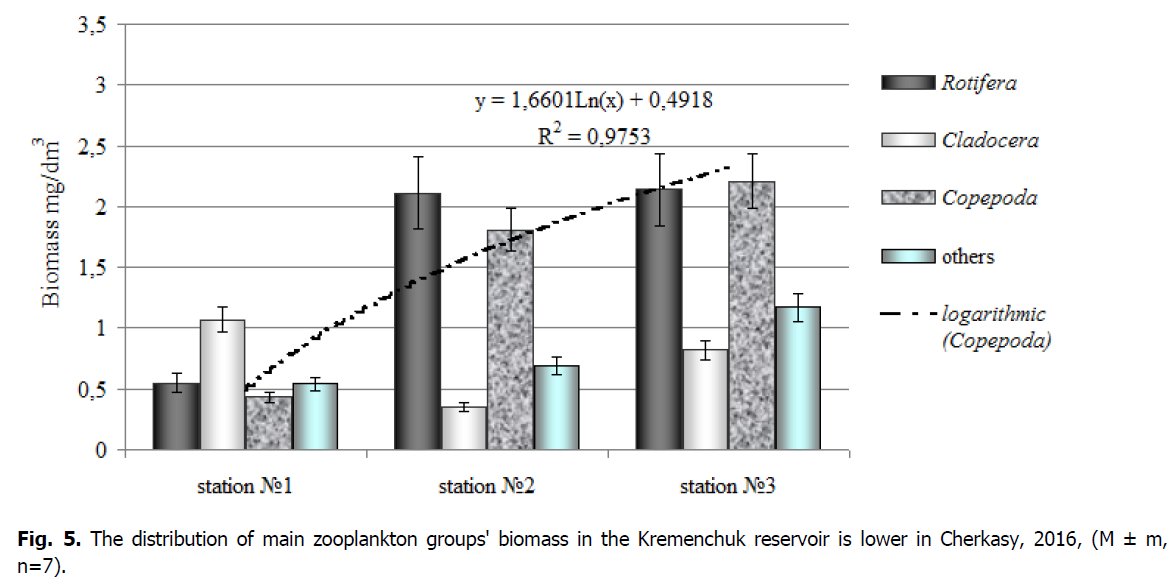
Figure 5: The distribution of main zooplankton groups' biomass in the Kremenchuk reservoir is lower in Cherkasy, 2016, (M ± m, n=7).
At station 2, zooplankton number reached 597 ± 18.53 (Cv=8.21) ind./dm3, the biomass was 4.97 ± 0.18 (Cv=9.69) mg/dm3, their formation occurs, mainly, due to the development of rotifers and copepods: in percentage, rotifers accounted for 63.3% in number and 42.5% in biomass, rowan crustaceans (Copepoda) were, respectively, 19.1% and 36.5%. Quantitative values of Dreissena larvae development increased by 28% compared to the values at the previous station, while their development rates were 0.69 ± 0.0.03 mg / dm3 and 69 ± 2.62 ind./dm3 (Cv=10.04). At the station № 3, zooplankton biomass made 6.34 ± 0.22 (Cv=8.98) mg/dm3, and the number was 918 ± 13.16 (Cv=3.79) ind./dm3. Similar to section №2, the general values were formed mainly by rotifers (34-67%) and, branched crustaceans (13-35%). The values of development of Veliger larvae increased 1.7 times, compared with the values at the previous station, while their share in zooplankton was 13-19%.
Conclusion
The water temperature was unstable; its maximum values (tmax) were a stress factor for plankton invertebrates of the reservoir. It is established that for each section of the water area certain specific Rotifera species are characteristiccertain specific Rotifera species are characteristic for each section of the water area: Hex. mira-at station 1; Lep. patella,, Myt. mucronata,, Br. forficula, Br. budapestinensis–at station 2; Poly. euryptera, Lec. luna, Synch. monopus, Aspl. priodonta var. henrietta, Al. quadrangularis–at station 3
The total zooplankton quantity and the temperature of the aquatic environment increased from top to bottom, and the difference between them was 3.3 times in number and 2.4 times in biomass. A positive close and significant correlation (k=0.83 and k=0.65, respectively) with changes in the temperature factor of the aquatic environment in space was established. This indicates the adaptation of aquatic organisms to the environmental conditions where they occupy habitats most favorable for their habitat.
On average, the basis of zooplankton was formed by eurythermic organisms-rotifers 64 ± 1.23% in number and 33 ± 6.18% in biomass, which are better adapted to significant fluctuations in daily temperature (recorded differences of 2-8°C/day).
Branched crustaceans, mostly thermophilic, accounted for only 7-41% in number and 8-19% in biomass, indicating unfavorable conditions for their development. The close negative correlation (k=-0.78 and k=-0.60) of Cladocera biomass with maximum temperatures t max indicates whitewash primarily of large forms of branched crustaceans under the action of temperatures.
Thus, the increase in water temperature beyond the optimal values harms the development of forage organisms and leads to a decrease in the productivity of the aquatic ecosystem.
References
Arsan, O.M., Davydov, O.A., Dyachenko, T.N. (2006). Methods of hydroecological research of surface waters. For order. V.D. Romanenko. NAS of Ukraine. Institute of Hydrobiology. Kyiv, LOGOS, p:408.
Bates, B.K., Kundtsevich, Z.V., Palyutikof, J.P. (2008). Climate change and water resources. Technical document Intergovernment. Climate Change Expert Group, IPCC Secretariat. Geneva, p:228.
Bogdanova, L.N. (1993). Characteristics of zooplankton of Kremenchuk reservoir. Rybn. hoz-vo. Kyiv, Urozhay, 47:58–60.
Buryak, G.O., Tkach, N.M., Grubinko, V.V. (2020). Development of algae in the river Seret in connection with climate change Materials Ternopil biological readings-Ternopil bioscience-2020 International scientific-practical conference, pp:133-136.
Gusinskaya, C.L. (1969). Zooplankton of the Kremenchuk reservoir in 1966–1967. Rybnoye khozyaystvo, pp:18–23.
Hutchins, D.A., Fu, F. (2017). Microorganisms and ocean global change. Nature Microbiology, 2:1-11.
Gillooly, J.F. (2000). Effect of body size and temperature on generation time in zooplankton. Journal of Plankton Research, 22:241-251.
Janauer, G.A. (2012). Aquatic vegetation in river floodplains: climate change effects, river restoration and ecohydrology aspects. In Climate Change, pp:149-155.
Kotovska, G.O., Khristenko, D.S. (2010). Conditions and efficiency of produced industrial actions of fish of Kremenchuk reservoir: Monograph. Kyiv, Agrar Media Group.
Kruzhilina S.V., Didenko, O.V. (2007). Structural and functional characteristics of zooplankton of Kremenchuk reservoir in the modern period and its relationship with some components of phytoplankton. Fisheries Science of Ukraine, 2:71-76.
Kutikova, L.A. (1970). Kolovratki fauna of the USSR. Leningrad: Nauka, p:744.
Magurran, A.E. (2004). Measuring Biological Diversity. Blackwell Publishing USA, p:255.
Monchenko, V.I. (2003). Free-living cyclopedic copepods of the Ponto-Caspian basin. Kyiv: Naukova Dumka, p:351.
Pashkova, O.V. (2017). Influence of temperature on the structural organization of zooplankton of the Kyiv reservoir. Proceedings of the VIII All-Ukrainian scientific-practical conference with international participation. "Biological Research–2017", p:3.
Pidgayko, M.L. (1969). Coastal zooplankton in the conditions of "flowering" of water in the Kremenchuk кeservoir. Hydrobiol Magazine, 5:26–34.
Pesenko, Yu.A. (1982). Principles and methods of quantitative analysis in faunal research. Moscow: Nauka, p:287.
Rudyk-Leuska, N.Y., Yevtushenko, N.Y., Khyzhniak, M.I., Leuskyi, M.V., Kononenko, R.V., Tson, N.I., Dumych, O.Y. (2020). Influence of temperature on the aquatic biota. Ukrainian Journal of Ecology, 10:102-105.
Rudyk-Leuska, N.Ya., Yevtushenko, N.Yu., Khyzhniak, M.I., Leuskyi, M.V., Tson, N.I., Dumyc, O.Y. (2020). Reflection of climate change on the temperature conditions of the middle section of the Kremenchuk reservoir. VII International Internet Conference, The world during a pandemic: new challenges and threats. Vancouver, Canada, p:82-86.
Shcherbak, V.I. (2019). Response of phytoplankton of the Kyiv Reservoir to the increase in summer temperatures. Hydrobiological Journal.
Sokolova, E.A. (2012). Influence of abnormally high temperature on zooplankton of Rybinsk reservoir. Proceed. All-Russian Conf. "Volga Basin in the XXI Century: Structure and Functioning of Reservoir Ecosystems", Russia, Borok, Izhevsk: IP Permyakov SA, 2012, pp:274–276.
Zhadin, V.N. (1960). Methods of hydrobiological research. Moscow: Higher School, p:192.
Zimbalevskaya, L.N., Sukhoyvan, P.G., Chernogorenko, M.I., Gurvich, V.V., Gusynslaya, S.L., Vyatchanina, L.I., Boshko, E.G. (1989). Invertebrates and fishes of Dnieper River and it reservoirs.
Author Info
N.Ya. Rudyk-Leuska*, M.I. Khyzhniak, M.V. Leuskyi, N.Yu. Yevtushenko, V.M. Kondratіuk, R.V. Kononenko and N.I. TsonCitation: Rudyk-Leuska, N.Ya., Khyzhniak, M.I., Leuskyi, M.V., Yevtushenko, N.Yu., Kondrat?uk, V.M., Kononenko, R.V., Tson, N.I. (2021). Peculiarities of zooplankton cenosis structure and development in the middle water area of Kremenchuk reservoir, Dnieper River (Ukraine), in conditions of elevated temperatures. Ukrainian Journal of Ecology, 11 (6), 63-68.
Received: 20-Jul-2021 Accepted: 31-Jul-2021 Published: 23-Aug-2021
Copyright: This is an open access article distributed under the terms of the Creative Commons Attribution License, which permits unrestricted use, distribution, and reproduction in any medium, provided the original work is properly cited.
